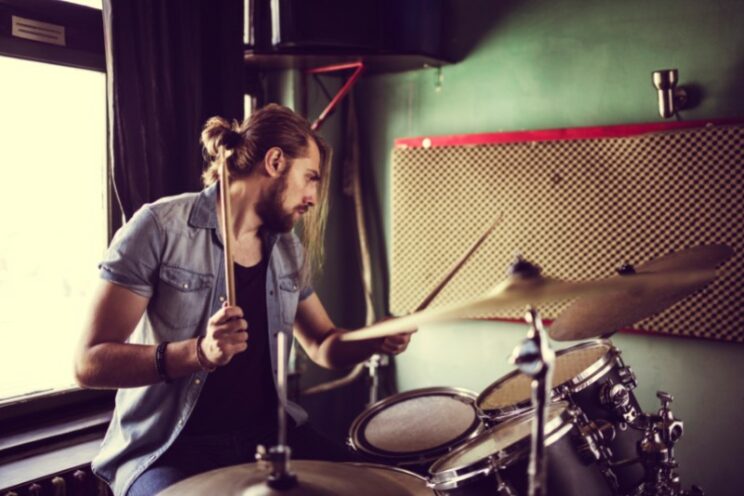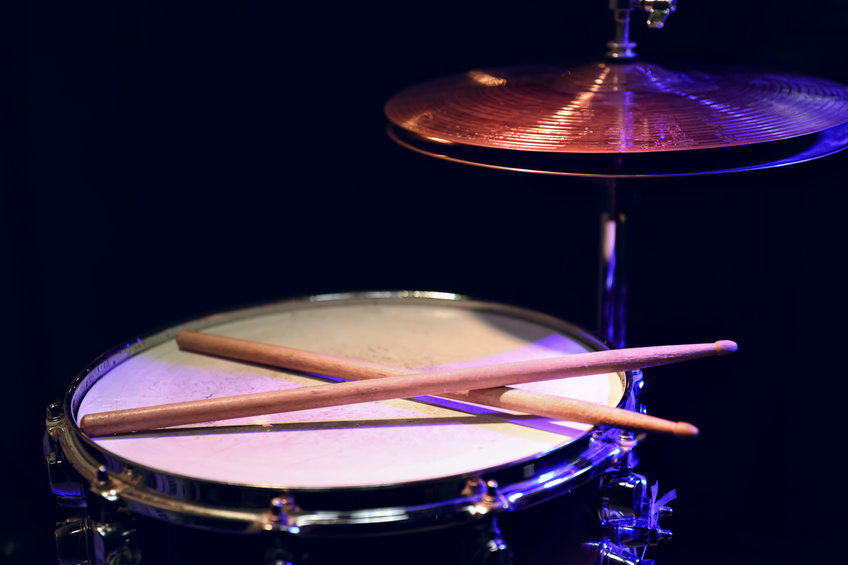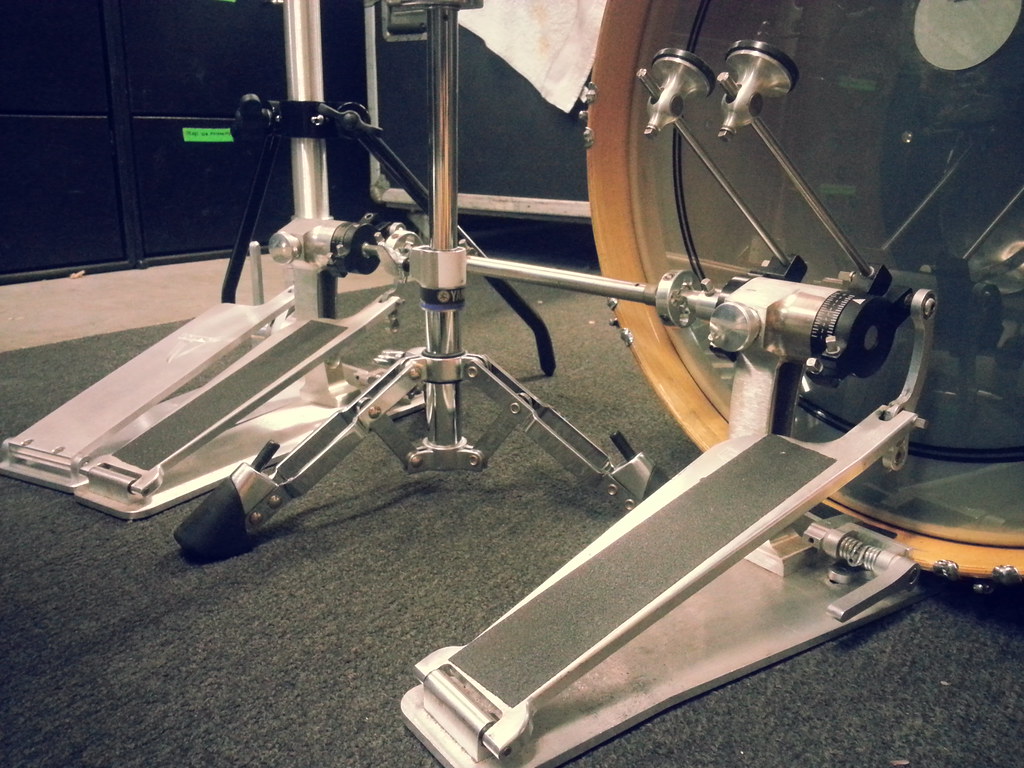Left-Handed Drumming (Differences, Challenges, Pros/Cons)

A drum set in a left-handed configuration simply mirrors a standard right-handed setup. Your hi-hat goes on the right, the right cymbal on the left, and the bass drum on the left.
Do left-handed drummers face extra challenges as they learn to play drums? How hard is it for left-handed people to play drums right-handed? Aren’t drummers supposed to be ambidextrous? Does playing left-handed yield any unique advantages?
As a summary:
- It can feel more natural for left-handed players to lead the hi-hat with their dominant hand.
- A standard drum set can be set up in a left-handed configuration just by switching the positions of the drums and cymbals. The same applies to many electronic drum sets.
- If you want to use a double-bass drum pedal, you would need to get a left-footed version (or a reversible one).
- Left-handed drum setup has its pros and cons. It can be very awkward for left-handed drummers if you need to share a kit for gigs, due to setup time and sound check.
- Teaching left-handed drummers can be a little challenging, particularly if the teacher only has one drum set.
- Open-handed drumming is an alternative option for lefties that want to play on a right-handed drum set configuration.
About one-tenth of the world’s current population is left-handed. But lefties often get the short end of the stick because society is oriented and designed for the majority.
For this very reason, many left-handed people are forced (either by teachers or due to a lack of options) to adjust or repurpose their wiring and learn things in an arguably unnatural way. This problem extends into the world of drumming as well.
In this article, we salute all southpaws out there and outline the general aspects of left-handed drumming alongside some helpful tips to help you understand what you are signing up for.
Contents
Right-handed vs Left-handed Drumming
The traditional technique to play drums is called the cross-handed technique. This works perfectly well for right-handed drummers because the conventional drum setup enables them to play the kick with their right foot, the hi-hat with their right hand, and the snare with their left.
Now if you place a left-handed person on their kit, they would need to make quite a few changes to play the kick with their left foot, hi-hat with the left hand, and snare with the right hand.
Let us assume you are a left-handed drummer. Your stronger/dominant hand will be your leading hand. This means you play time with your left (hi-hat) and the backbeat (snare) with your right. If you play a simple eighth note beat for one measure (four counts), you will strike the hats eight times (left hand) and hit the snare (right hand) only twice.
Do you see how your dominant hand does more work? Add syncopation or imagine complex fills at 140bpm and it becomes a lot more relevant.
If you tried to do it the other way around – your right hand would play eight times and your left would only play twice. As a southpaw, you are probably more comfortable with your left hand playing the hi-hat. But this means you need to mirror the drum kit and set it up in a completely different way than a right-handed drummer would.
But isn’t it possible for a left-handed person to play right-handed drums? Yes, of course. With enough training, this can be achieved and it has been done by numerous world-class musicians. Most southpaws find no difficulty in learning and playing the drums as if they were right-handed. However, this may take additional effort during the early stages of your learning.
Should you learn to play left-handed?
If you’re left-handed, then playing a drum set in a left-handed configuration can feel more natural.
As for the cons, you will find it hard to share a drum set in jam sessions or on stage with other bands. You may also have trouble finding an instructor or feel disoriented while watching instructional videos.
Luckily, you don’t need any special drum kit because you are left-handed. The exact same drum kit can be set up in a different way to accommodate a left or right-handed player. But, the kit will be oriented in the opposite way (mirrored).
The only exception to this is a double pedal which is not mandatory to use and is only applicable to intermediate drummers and certain genres, and lastly, has an easy workaround because reversible double pedals are now being sold in the market.
As for learning, most teaching materials (like drills and paradiddles) have the same exercise starting with both hands. This is because the end game as a drummer is to be ambidextrous and attain identical skill and agility in playing and leading with each hand.
So the long answer is: It is perfectly fine to play left-handed drummer as long as you are fine with the consequences. Alternatively, if you can shift to playing right-handed, this may be a more practical choice in the long run.
The Third Option: Open-Handed Drumming
Open-handed drumming is considered to be a different technique altogether. It is also referred to as ‘uncrossed’, ‘open-handed-drumming’, or ‘left-hand leading’. As the name suggests, an open-handed style entails not crossing your hands while you play.
A conventional righty drummer, for example, will play the snare with his left hand and cross his right hand over to play the hi-hat. An open-handed drummer would play the snare with his right hand and hi-hat with his left. As a left-handed drummer, open-handed drumming would be slightly easier because you can play on a right-handed drum kit and still lead with your left hand.
Most open-handed drummers modify the kit in a way that doesn’t require them to cross their hands at any point while playing time. This usually means shifting the ride and cymbals to the same side as the hi-hat. But it isn’t bound to any rules or genre and with a little creativity, you can make things work in any context.
Tips for teaching left-handed players

Teaching southpaws can be challenging for right-handed instructors. The main reason for this is that private instructors usually have only one drum kit in the rehearsal space.
This means you have to constantly reorient the kit and reposition it again when that student leaves and the next right-handed student walks in. This can be time-consuming, tedious, and confusing.
Even if you have two kits, there can be a lot of confusion when you explain concepts and all the visual cues a student gets from an instructor can disorient them.
The obvious workaround to this problem is to teach students to play the same way as any right-handed person would. Although, this would be easier for the instructor and may lead to a sharp adjustment curve and discomfort for the student.
I say ‘may lead to’ because most left-handers have spent their whole life using right-hand oriented equipment (like a computer mouse or a car) which trains them to some extent to lead the drums with their right hand.
It is not an insurmountable task and many great drummers are left-handed but play right-handed, probably for the same reason.
When we say ‘left-handed’ we tend to forget about the feet. Just like the arms, everyone has a dominant foot and an off-foot. Can you imagine asking a pro-athlete soccer (football) player to take a penalty kick with his off foot?
Luckily, many southpaws have a dominant right foot. If this is the case, there is a chance that they can comfortably switch to playing right-handed. Additionally, you can opt to teach them the open-handed technique which we will discuss later.
In conclusion, instructors should use workarounds only if they feel that a left-handed student is equally enthused about it. Even so, open-handed drumming seems like a more compassionate option than entirely reorienting a student’s physiological preponderance.
Ultimately, forcing a southpaw to play right-handed will diminish their interest and result in them eventually quitting. This is best dealt with on a case-by-case basis. Take some time to experiment with all the options and see how a student responds. Take memorandum of his grasping power, comfort level, and physical preferences. Prioritize their preference above your comfort. At the very least, a new challenge will help you improve as a teacher as well.
Famous Left-Handed Drummers:
Here is a brief list of noteworthy drummers who have led the way:
Left-Handed Drummers
Phil Collins (Genesis), Ralph Johnson (Earth, Wind, and Fire), Ian Haugland (Europe), Charles Connor (Little Richard), Al Sobrante (Green Day), Ian Paice (Deep Purple, Whitesnake), Dominic Howard (Muse) and many others.
Left-Handed Drummers who played Open-Handed:
Dennis Wilson (Beach Boys), Billy Cobam (Mahavishnu Orchestra, Miles Davis), Lenny White (Miles Davis), Scott Travis (Judas Priest), Carter Beauford (Dave Matthews Band), and many others.
Conclusion
There are times when being a left-handed drummer may feel like you are swimming against the tide. But in the larger picture, regardless of what you choose, you ought to be fine. And for all you southpaws out there, don’t forget – we’ve still got it better than lefty guitarists… well, at least in this aspect!
Featured Image of Dom Howard by © Markus Felix | PushingPixels / CC BY-SA







